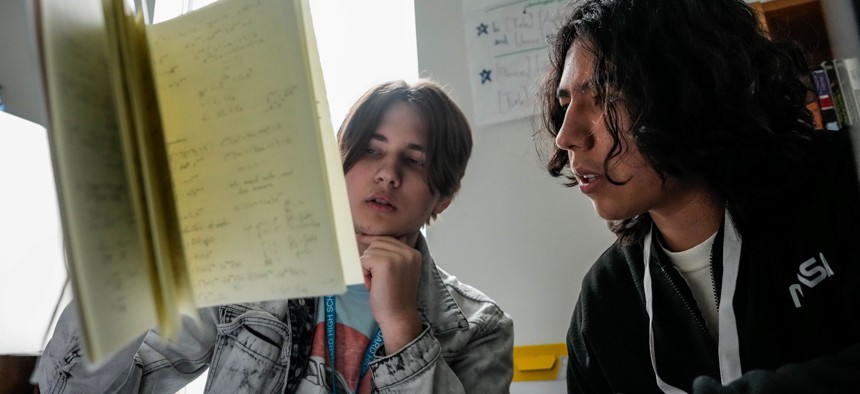Achieving racial equity in college admissions starts in pre-K

Israel Garcia, 17, studies for an exam with his classmate Nazar Bevzenko, 17, during lunch hour at Carnegie Vanguard High School on Thursday, Nov. 9, 2023, in Houston. Raquel Natalicchio/Houston Chronicle via Getty Images
COMMENTARY | The class of 2028 is the first college class to be admitted after the end of affirmative action. Without it, we need big-picture reforms.
This is the time of year when colleges decide which students to admit, and students across the country decide which school to attend. Students who have made their decision are filling their Instagram feeds with portraits framed with their new school’s colors and mascot. But the class of 2028 is different from its predecessors: These students began high school remotely because of COVID-19. They are navigating the chaotic rollout of the new Free Application for Federal Student Aid or FAFSA. And they are the first class enrolling in college after the U.S. Supreme Court ended affirmative action last June, all but eliminating the use of race in college admissions decisions. While it is too early to say how this Supreme Court decision will affect diversity on campus, research suggests admissions will likely drop for students who are Black, Indigenous and other people of color, or BIPOC, especially at elite four-year institutions.
The high court did not deny that diversity serves important educational objectives, arguing only that the means employed to meet the end were impermissible. To find other paths to diverse institutions and the many educational and societal benefits that they bring will require tackling the inequities that begin much earlier in students’ education.
Colleges and universities—most of whom condemned the Supreme Court decision—are furiously looking for permissible, race-neutral policies and practices to help them maintain some level of racial and ethnic diversity on their campuses.
Promising evidence-based options include identifying more ways to create a greater diversity of qualified applicants, ensuring that lower-income students know when they are eligible for state and institutional aid, working with state policymakers to streamline transfers between community colleges and public higher education institutions, and exploring more comprehensive measures of adversity or disadvantage than household income or parent education.
Most research has found, however, that these approaches would not achieve the same level of racial and ethnic diversity in college admissions as affirmative action has over the past decade. Additionally, these measures do not address the problem that prompted schools to consider race in college admissions to begin with: inequities in pre-K-12 education, stemming from the nation’s history of systemic racial discrimination.
Black students are less likely to have access to quality preschools and are more likely to face obstacles like food insecurity and homelessness. By the time they enter kindergarten, on average they are almost a year behind their white classmates in math ability and six months behind in reading. Nearly 40% of Black and Hispanic students attend high-poverty schools with few academic resources, compared with just 7% of white students. The schools with the greatest shares of students who are behind academically have the fewest resources to address the disparities. As a result, the gaps in reading and math persist at age 9 and age 13. This makes it difficult for many BIPOC students to take advantage of college preparatory courses like Advanced Placement classes, if their high school even offers them (40% of high-poverty schools do not). Additionally, many of these students lack counselors to advise them on their academic choices. These persistent inequities across K-12 education put many BIPOC students at a distinct disadvantage when applying to four-year colleges and universities, particularly highly selective schools that rely heavily on such measures as standardized test scores and college preparatory class participation when deciding which students to admit.
Addressing these gaps would require big-picture reforms. To begin with, state and local policymakers need to better align high school graduation requirements and college admissions standards. But they must also address the conditions that create pervasive inequality. That means funding schools more equitably so high-poverty districts have access to the resources they need for their students to be as successful as those in more affluent districts. It also means addressing the obstacles that touch all parts of BIPOC Americans’ lives: housing and food insecurity, inadequate health care, and violence and crime—all of which affect their academic performance.
When students arrive on campus in the fall, there will be an intense focus on gauging the Court’s impact on the make-up of student bodies. But it’s also a good opportunity to turn attention to root causes of inequity that children face throughout their lives.
Bryan J. Cook is the director of higher education policy at the Urban Institute, a nonprofit social and economic policy research organization. Before joining Urban, he served as vice president for data and policy analysis at the Association of Public and Land-grant Universities.
Sarah Rosen Wartell is the president of the Urban Institute. She served as deputy assistant to the president for economic policy and deputy director of the White House National Economic Council in the Clinton administration.





